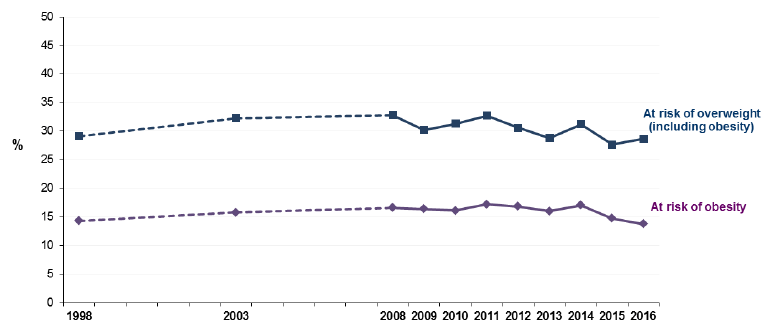Obesity indicators 2017
Annual report of the latest results for the indicators selected to monitor progress of our Prevention of Obesity Route Map (2010).
This document is part of a collection
Children at risk of overweight and obesity
Indicator Source: Scottish Health Survey
Latest Results
- In 2016, 14% of children aged 2 to 15 were at risk of obesity, with a further 15% at risk of overweight.
- Since 1998, the proportion of children aged 2-15 at risk of overweight (including obesity) has fluctuated between 28% and 33%, and was 29% in 2016.
- In 2016, the figure for those at risk of overweight (including obesity) in girls was higher than for boys (29% compared to 28%), though the reverse was true prior to 2014 - however these differences were not statistically significant. The same proportion of boys and girls were at risk of obesity (14%).
- The figure for those at risk of overweight (including obesity) was highest among those children aged 12 to 15 (33%). Of girls this age, 37% were at risk of overweight including obesity. The equivalent figure for boys of the same age was 29%.
Figure 3: Proportion of children (2-15) at risk of overweight and obesity, 1998-2016

- The same proportion of children are at risk of obesity in Scotland’s most deprived areas as the least deprived (both 11%). The gap between rates in the most and least deprived areas has fluctuated over time, with a high of 11 percentage points in 2011. The 2 nd most deprived areas [4] of Scotland had the highest proportion of children at risk of obesity (19%).
Figure 4: Proportion of children (2-15) at risk of obesity by area deprivation [5] , 1998-2016
![Figure 4: Proportion of children (2-15) at risk of obesity by area deprivation[5], 1998-2016 Figure 4: Proportion of children (2-15) at risk of obesity by area deprivation[5], 1998-2016](/binaries/content/gallery/publications/statistics-publication/2017/11/obesity-indicators-monitoring-progress-prevention-obesity-route-map/00527558.gif)
About This Indicator
Desired Outcome:
Fewer children in Scotland overweight and obese.
Definitions:
At risk of overweight (including obesity) – BMI at or above 85th percentile
At risk of obesity – BMI at or above 95 th percentile.
(Based on UK 1990 reference chart cut-offs).
Geography available:
National, Health Board.
Equalities data:
Breakdowns by four equalities groups may be possible (sexual orientation and religion are not asked of children), but not all are available annually.
Rationale for including this indicator:
The aim of this indicator is to monitor changes in the proportion of Scotland’s children who are overweight and obese. It is used to identify any different patterns (and hence need for specific policy focus) amongst children of different ages. It is a long term measure of success of the Route Map.
Factors influencing this indicator [6] :
- Diet, physical activity and sedentary behaviour are strongly associated with BMI.
- Parental BMI: children with an obese parent are significantly more likely to be at risk of being overweight including obese than both those with an overweight parent and those with no overweight parent. They are also significantly more likely to be at risk of being obese.
- Household income: boys in the lowest income households are more likely than those in other households to be obese. There is no clear association for girls.
Contact
There is a problem
Thanks for your feedback